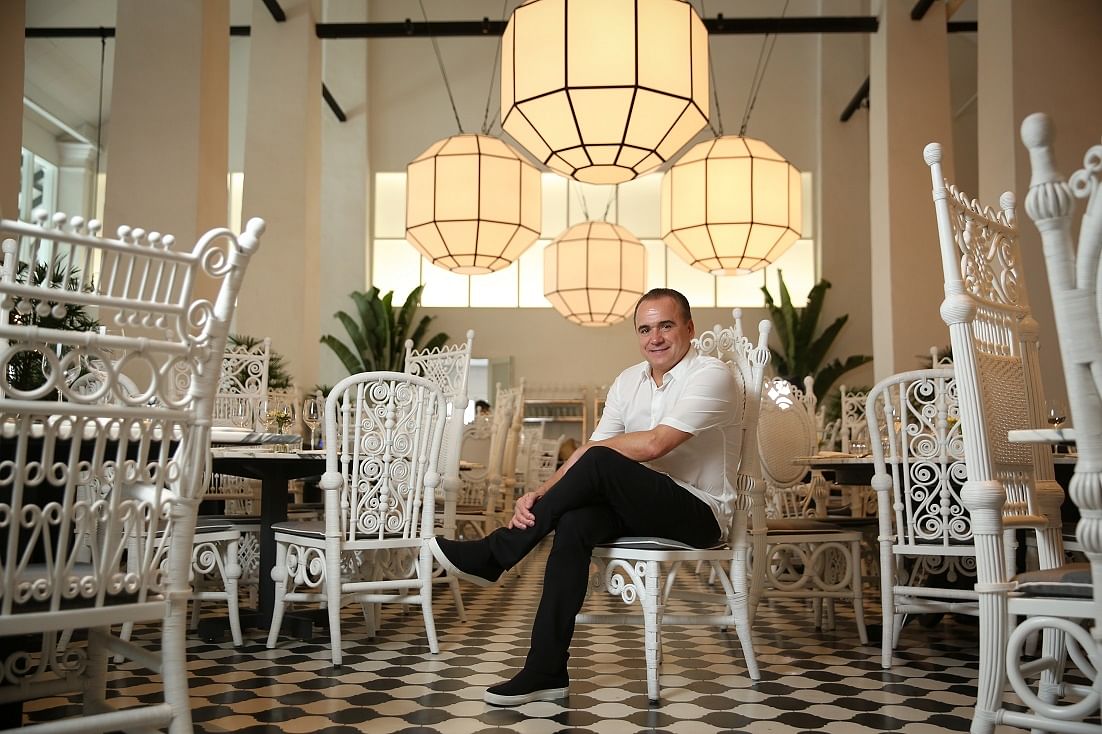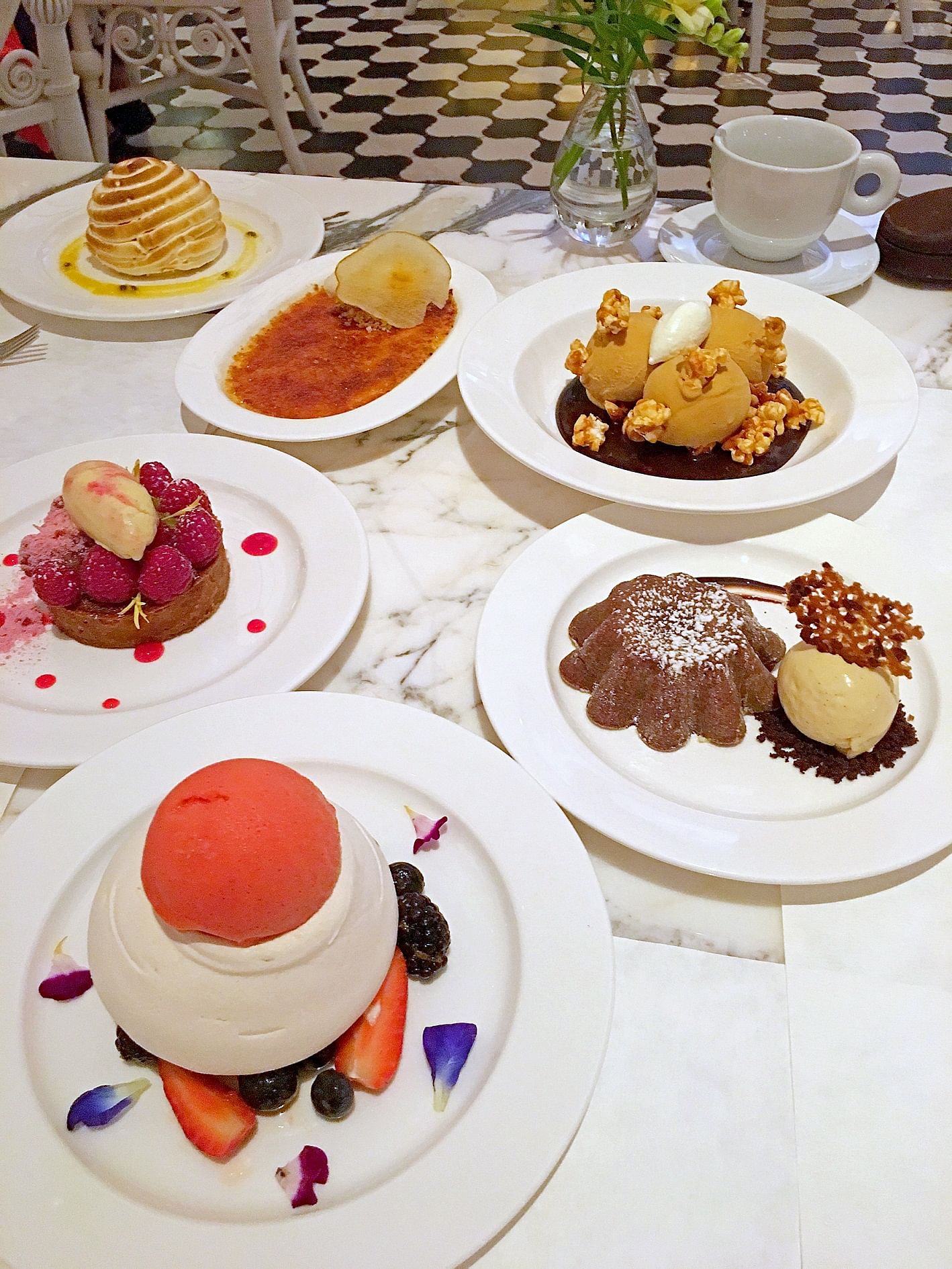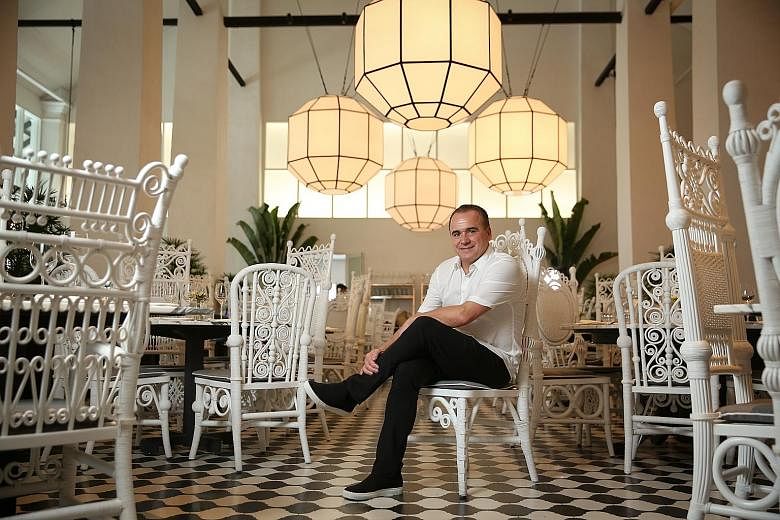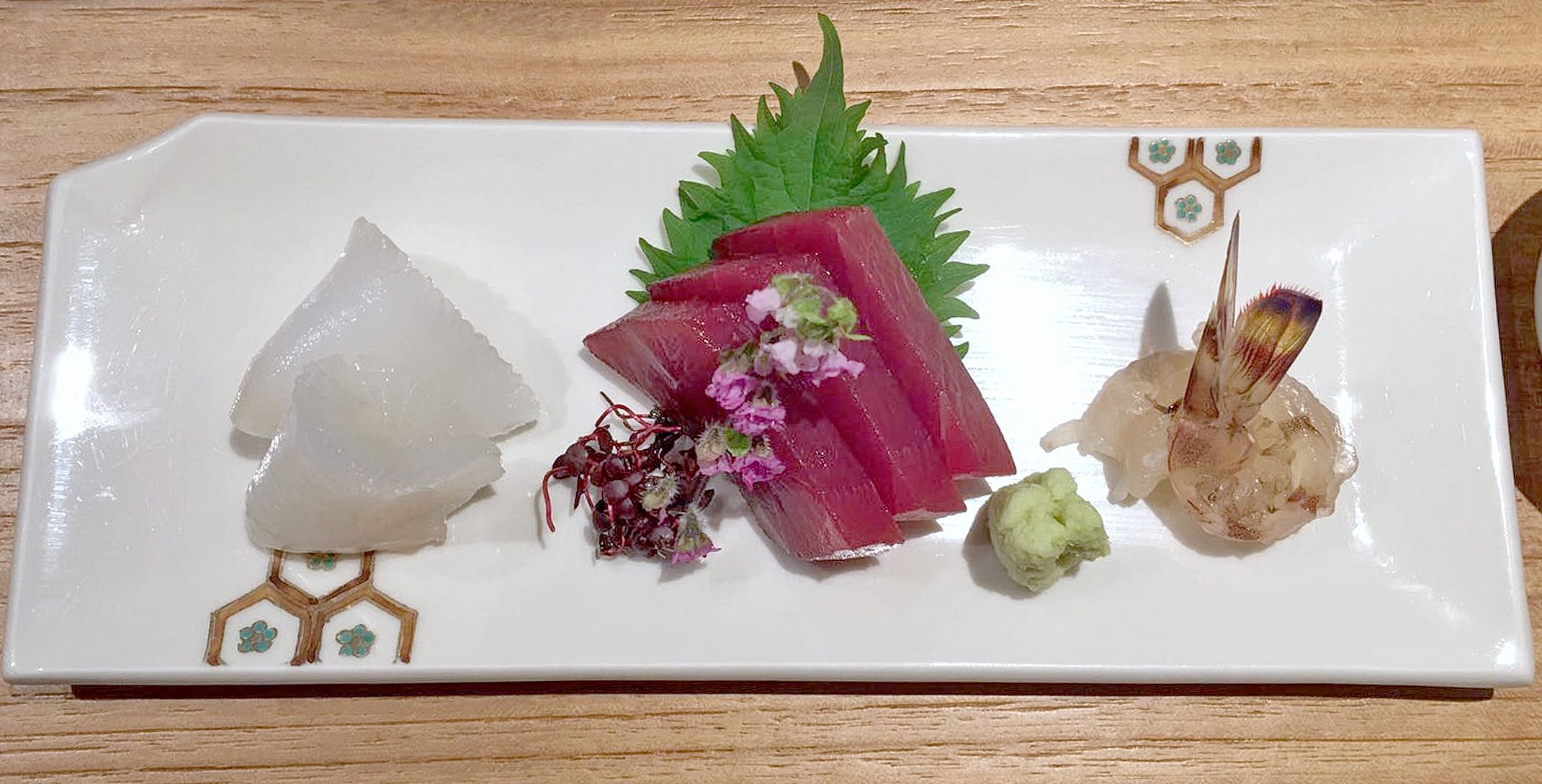My palate fails me when the carrots from Kyoto arrive.
I'm having lunch with Jean-Georges Vongerichten, one of the world's most celebrated chefs, and we're at Ippoh Tempura Bar, a Japanese restaurant.
Vongerichten mentions - twice - how good the carrots here are. He was at Ippoh a few days ago, he says, and they were so "amazing" and "absolutely delicious" that he decided to get them for his own restaurant, to be used in a salad.
When the carrots are served, I bite into them expectantly. They are sweet and the flesh - more red than orange - does seem rather tender. But if he hadn't pointed out to me that these carrots are special, I wouldn't have known better.
Vongerichten, though, looks to be seriously enjoying the carrots. So as not to give away how undiscerning my tastebuds are, I make appreciative noises too.
Kyoto Red carrots are actually a good introduction to Vongerichten, who was born in France but is now based in New York City.

The carrots are from Asia, they are fresh, and they are a premium ingredient - terms you could also apply to his approach to cooking.
He is the man lauded by foodies around the world for reinventing French cuisine. His French-based dishes use plenty of Asian herbs and flavours and lots of fresh vegetables, and, unlike traditional French cooking, are less heavy. Think foie gras with lychee sauce and chicken with kumquat lemongrass dressing.
He has 35 restaurants around the world, including 11 in New York City, among them the three-Michelin-star Jean-Georges in Trump International Hotel & Tower. He has also written cookbooks, such as the 1990 classic Simple Cuisine.

He was in town to open The Dempsey Cookhouse and Bar, his first restaurant in Singapore.
It is done in partnership with Como Dempsey, part of the Como Lifestyle arm of the Como Group. The informal restaurant in Dempsey Hill offers the best of his dishes in a pretty, colonial-style setting, and is next to Ippoh and Candlenut, a Peranakan eatery.
Because the Cookhouse is currently open only for dinner (it has since added brunch on weekends), Vongerichten, 60, decides to eat at Ippoh. It's mostly counter seating and I plant myself in a corner to wait for him. He arrives on time, a trim, neatly groomed man with dark, swept-back hair and soft, brown eyes. He's wearing a fitted short-sleeved white shirt and black trousers, and looks younger than his age.
I'd been told by the public relations folks that he's "super-friendly" and I discover they are right. During our 90-minute lunch, he is warm and charming and has an infectious, chuckling laugh. He is, of course, media savvy, having been in the business for so long, and he knows which sound bites work, but the personal charisma comes through.
I don't know if most chefs wax lyrical about food, but he is certainly enthusiastic about his.
He relates how he was at Candlenut and found the Peranakan flavours "amazing and really strong". He'd also eaten at other Dempsey eateries such as Jumbo Seafood, PS Cafe and Open Farm Community. He had a great time at Geylang Serai market too, where he had thosai, a picture of which he uploaded onto his Instagram @chefjgv.
"I love eating," he says in melodic French-accented English. "I think maybe in my past life, I was Asian. I like small bites, I don't like the big American plates," he laughs. "I eat moderate, that's why I like Asian food - tempura, sushi, one thing at a time. I like big flavours but don't like big volumes."
He tells me the Cookhouse menu includes a yellowfin tuna tartare with avocado and ginger marinade. There's also salmon sushi atop a deep-fried rice cake dribbled with chipotle mayonnaise. "You try tonight. It's good," he says, and already I'm excited.
He didn't do a fine dining restaurant here because he's too far away to manage it properly. As for why his name is not on the restaurant, he points to the Cookhouse's menu - which he has brought along - and says "my name is on the menu".
"We don't want to confuse people," he continues. "If it's Jean-Georges, many people expect tablecloths, they will expect all the high-end things". The Cookhouse name, he adds, is suitable because the building was the former cookhouse of the British army here.
We decide to order. I opt for the lightest option - an eight-piece tempura set - and he does the same. "You want sashimi to start?" he asks and I nod.
Although the Cookhouse is his first venture here, he is no stranger to Singapore. Since 2010, he has been visiting Singapore to provide the food at the exclusive Paddock Club at the Singapore Grand Prix.
His roots actually sink deeper. Back in 1983, he was based in Singapore for about four months, overseeing the French restaurant at the Le Meridien hotel in Orchard Road. He reminisces how there was more street food then. "Singapore has really expanded a great deal."
The sashimi arrives, glistening pieces of squid, tuna and shrimp. He's left-handed and a deft user of chopsticks. "Wow, this is like so fresh. The shrimp is going to be crazy. And I love wasabi, my favourite," he murmurs.
He grew up in Alsace in France and his family owned a small coal-handling business. At 16, he left school for an apprenticeship at a three-Michelin-star restaurant. He went on to work with top chefs like Louis Outhier, and was sent to open restaurants outside France, including in the Oriental Hotel in Bangkok and the Le Meridien here. He was in Asia for five years.
Bangkok, he has always said, was the turning point in his career. He was blown away by Asian herbs and flavours and the possibilities of using them in French cooking. Ginger remains his favourite ingredient today.
The United States was where he found fame. In 1985, he went to Boston to open a restaurant, and the next year to New York City. His approach to French cuisine at the Lafayette in the Drake Swissotel won him a coveted four-star review from The New York Times.
In 1991, he and American financier Phil Suarez opened a bistro, JoJo - his nickname as a boy - which won rave reviews. From one restaurant, the business grew, and today, he has 5,000 people working in his restaurants around the world, including in the Bahamas, Tokyo and Shanghai. He owns and runs 11 and the others are done with partners.
Our starter has arrived - sesame tofu with uni and a salad. He praises the simple, wooden, brown trays they come in and says"uni is my favourite food".
Besides the food, he is involved in every aspect of his restaurants. He is finicky about lighting, for example. Customers have to see what they're eating but the lights must also make them look good.
"I feel like food, a restaurant, is one of the last pleasures. If the light is stressing or the set-up is stressing, it doesn't work. So a restaurant starts with it being pleasing to the eye, comfortable, non-aggressive, and the food must be good, of course."
The concept of the Cookhouse is "very white, very pure", and with its high ceilings, plants and tall wicker chairs, harks back to the glamour of Singapore in the 1920s and 1930s.
There are other things he is particular about, like how a menu mustn't be too long or it would stress the diner out, and how it must never be stained.
A key ingredient to his success is his philosophy that restaurants are there to make people happy.
"We are here to please people in this business and that's what counts," he says.
"I would never be in this business if I can't please people. If you are an angry chef, do something else. No matter what, you survive only if your customers are happy... Good food, good service, good value."
While the rise of food bloggers and social media has added pressure to the business, he sees this as a positive thing as it's no longer just the food critic who has a say. "Today, everyone is a critic, which is good in a way for us because the critic is one person's view. Now, today if I read online that 10 people say the hot sauce is too hot, I'll adjust it."
For example, he tweaked the salt level at the Cookhouse after he heard that three diners found the food too salty. That came about because the original recipe used kosher salt whereas fine salt is used here, he says.
Does he get offended by criticism, I wonder.
"No. I want to please you. You come to me and you're paying for the experience, I'm not going to say, 'Ah, if you don't like it, go somewhere else.' I want you to come back," he says.
"It took me a long time to be like this. I've been cooking for 43 years now, so in the beginning, you're like a little hot-headed, you feel like, 'Oh, don't like it? Go to hell, whatever'. " He laughs. "But today, 43 years later, it's a different business with the phones, with the communication of people, everything is important."
Consistency and quality in his restaurants are maintained through very precise recipes, and when he does a special, this will be taped and sent to his chefs around the world.
I ask if he sees himself as a chef or a businessman first. "First as a chef," he replies without hesitation. "A chef with lots of ideas."
His office is in Soho in New York City. He starts his day at 8am with an hour at the gym, then heads for the office. "In the morning from nine to 11, I'm a businessman because I go to my office. From 12 to 8.30 at night, I'm in the kitchen. From 8.30 on, I'm like a customer, I go to my restaurants, I eat, I entertain," he says. "So businessman, chef, entertainer. My life is complete." He gives another of his infectious chuckles.
His South Korean-born wife, Marja, 40, is also a cook and has done TV shows and cookbooks. They have a daughter, 16, and he has a son, 35, and a daughter, 29, from his first marriage, and two grandchildren.
We move on to the tempura, which includes fukinoto, a spring mountain vegetable with a bitter taste. He takes a photo of it. I wonder if he ever eats fast food. He says rarely, but he had a Shake Shack burger recently at an airport because "I never miss a meal and it was better than airplane food". And how was it? "Good".
He says Singaporeans are lucky because there's so much fast food here. I must have looked puzzled because he adds that he regards food like thosai as fast food, and not only are they quickly and readily available, they are healthy too.
That night, I go with my food reviewer colleagues Wong Ah Yoke and Tan Hsueh Yun for a tasting at the Cookhouse. Vongerichten is in his chef uniform and, in between overseeing the kitchen, goes around talking to diners.
We're given 10 of his dishes to try, and six desserts. Many are delicious, especially the salmon sushi he'd talked about earlier, and his famous molten chocolate cake.
I'm bursting by the time we leave. "Sorry, sorry, you had too much food," he tells me when we say goodbye.
I'm not sorry, of course. If his mission is to make his customers happy, he succeeded because I rolled out of the restaurant one very happy diner that night.
Twitter @STsumikotan



